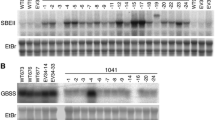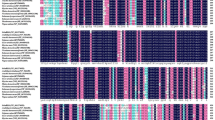Abstract
Analysis of the levels of starch phosphorylase mRNA and its product in the various organs of the potato plant indicates that the gene is differentially regulated, leading to a high accumulation of the gene product in tubers. The amount of phosphorylase transcripts synthesized in nuclei isolated from tubers and leaves indicates that the difference in the steady-state levels of phosphorylase mRNA in these organs can be explained by different rates of initiation of transcription. However, while rates of initiation of transcription are similar in tubers and stems, the steady-state level of phosphorylase mRNA is much lower in the stem. Transgenic potato plants expressing the β-glucuronidase (GUS) gene under the control of 5′-flanking sequences of the phosphorylase gene exhibited high levels of GUS activity in petioles, stems, stolons, tubers and roots, but low levels in leaves. This confirms the results of transcription assays observed for leaves, stems and tubers, and indicates that accumulation of phosphorylase mRNA in stems and tubers is not controlled solely by transcription initiation. Finally, histochemical analysis for GUS activity in transgenic potato plants suggests that transcription of the phosphorylase gene predominantly occurs in starch-containing cells associated to vascular tissues, and suggests a role for starch phosphorylase in the mobilization of starch stored along the translocation pathway.
Similar content being viewed by others
References
Bevan M: Agrobacterium vectors for plant transformation. Nucl Acids Res 12: 8711–8721 (1984).
Bradford NM: A rapid and sensitive method for the quantitation of microgram quantities of protein utilizing the principle of protein-dye binding. Anal Biochem 72: 248–254 (1976).
Brisson N, Giroux H, Zollinger M, Carmirand A, Simard C: Maturation and subcellular compartmentation of potato starch phosphorylase. Plant Cell 1: 559–566 (1989).
Camirand A, St-Pierre B, Marineau C, Brisson N: Occurrence of a copia-like transposable element in one of the introns of the potato starch phosphorylase gene. Mol Gen Genet 224: 33–39 (1990).
Chang TC, Lu SC, Su JC: Sweet potato starch phosphorylase: purification and characterization. Agric Biol Chem 51: 187–195 (1987).
Chiang CL, Lu YL, Juang RH, Lee PD, Su JC: Native and degraded forms of sweet potato starch phosphorylase. Agric Biol Chem 55: 641–646 (1991).
Cleveland DW: Gene regulation through messenger RNA stability. Curr Opin Cell Biol 1: 1148–1153 (1989).
Davies HV, Ross HA: The pattern of starch and protein degradation in tubers. Potato Res 27: 373–381 (1984).
Davies HV, Ross HA: Hydrolytic and phosphorolytic enzyme activity and reserve mobilization in sprouting tubers of potato (Solanum tuberosum L.) J Plant Physiol 126: 387–397 (1987).
De Block M: Genotype-independent leaf disc transformation of potato (Solanum tuberosum) using Agrobacterium tumefaciens. Theor Appl Genet 76: 767–774 (1988).
Dickey LF, Gallo-Meagher M, Thompson WF: Light regulatory sequences are located within the 5′ portion of the Fed-1 message sequence. EMBO J 11: 2311–2317 (1992).
Elliot RC, Dickey LF, White MJ, Thompson WF: cis-Acting elements for light regulation of pea ferredoxin I gene expression are located within transcribed sequences. Plant Cell 1: 691–698 (1989).
Esau K: Anatomy of Seed Plants, 2nd ed. John Wiley, New York (1977).
Fukui T: Plant phosphorylase. In: Akazawa T, Asahi T, Imaseki H (eds) The New Frontiers in Plant Biochemistry, pp. 71–82. Japan Scientific Societies Press, Tokyo (1983).
Fukui T, Nakano K, Tagaya M, Nakayama H: Phosphorylase isozymes of higher plants. In: Korpela T, Christen P (eds) Biochemistry of Vitamin B6, pp. 267–276. Birkhauser Verlag, Basel (1987).
Green P: Control of mRNA stability in higher plants. Plant Physiol 102: 1065–1070 (1993).
Greenblatt J, Nodwell JR, Mason SW: Transcriptional antitermination. Nature 364: 401–406 (1993).
Harford JB, Rouault TA, Klausner RD: Regulating the fate of mRNA: the control of cellular iron metabolism. Cell 72: 19–28 (1993).
Hensgens LAM, Fornerod MWJ, Rueb S, Winkler AA, van derVeen S, Schilperoort RA: Translation controls the expression level of a chimaeric reporter gene. Plant Mol Biol 20: 921–938 (1992).
Hwang PK, Fletterick RJ: Convergent and divergent evolution of regulatory site in eukaryotic phosphorylases. Nature 324: 80–84 (1986).
Hwang PK, Tugendreich S, Fletterick RJ: Molecular analysis of GPH1, the gene encoding glycogen phosphorylase in Saccharomyces cerevisae. Mol Cell Biol 9: 1659–1666 (1989).
Iwata S, Fukui T: The subunit structure of α-glucan phosphorylase from potato. FEBS Lett 36: 222–226 (1973).
Jefferson RA, Kavanagh TA, Bevan MW: GUS fusion: β-glucuronidase as a sensitive and versatile gene fusion marker in higher plants. EMBO J 6: 3901–3907 (1987).
Jones JDG, Dunsmuir P, Bedbrook J: High level expression of introduced chimeric genes in regenerated transformed plants. EMBO J 4: 2411–2418 (1985).
Keeling PM, Wood JR, Tyson RH, Bridges IG: Starch biosynthesis in developing wheat grain. Plant Physiol 87: 311–319 (1988).
Lincoln JE, Fischer RL: Diverse mechanisms for the regulation of ethylene-inducible gene expression. Mol Gen Genet 212: 71–75 (1988).
Linial M, Gunderson N, Groudine M: Enhanced transcription of c-myc in bursal lymphoma cells requires continuous protein synthesis. Science 230: 1126–1132 (1985).
Ludevid D, Höfte H, Himelblau E, Chrispeels MJ: The expression pattern of the tonoplast intrinsic protein γ-TIP in Arabidopsis thaliana is correlated with cell enlargement. Plant Physiol 100: 1633–1639 (1992).
Maniatis T, Goodburn S, Fischer J: Regulation of inducible and tissue-specific gene expression. Science 236: 1237–1245 (1987).
Müller-Röber B, Kossmann J, Hannah LC, Willmitzer L, Sonnewald U: One of two different ADP-glucose pyrophosphorylase genes from potato responds strongly to elevated levels of sucrose. Mol Gen Genet 224: 136–146 (1990).
Müller-Röber B, La Cognata U, Sonnewald U, Willmitzer L: A truncated version of an ADP-glucose pyrophosphorylase promoter from potato specifies guard cellselective expression in transgenic plants. Plant Cell 6: 601–612 (1994).
Murashige T, Skoog F: A revised medium for rapid growth and bioassays with tobacco tissue cultures. Physiol Plant 15: 473–477 (1962).
Nakano K, Mori H, Fukui T: Molecular cloning of cDNA encoding potato amyloplast α-glucan phosphorylase and the structure of its transit peptide. J Biochem (Tokyo) 106: 691–695 (1989).
Ni W, Trelease RN: Post-transcriptional regulation of catalase isozyme expression in cotton seeds. Plant Cell 3: 737–744 (1991).
Oparka KJ: What is phloem unloading? Plant Physiol 94: 393–396 (1990).
Patrick JW: Sieve element unloading: cellular pathway, mechanism and control. Physiol Plant 78: 298–308 (1990).
Preiss J: Biosynthesis of starch and its regulation. In: Loewus FA, Tanner W (eds) Encyclopedia of Plant Physiology, vol. 13A, pp. 397–417. Springer-Verlag, New York (1982).
Rosahl S, Eckes P, Schell J, Willmitzer L: Organ-specific gene expression in potato: isolation and characterization of tuber-specific cDNA sequences. Mol Gen Genet 202: 368–373 (1986).
Rowland LJ, Strommer JN: Anaerobic treatment of maize roots affects transcription of AdhI and transcript stability. Mol Cell Biol 6: 3368–3372 (1986).
Sachs AB: Messenger RNA degradation in eukaryotes. Cell 74: 413–421 (1993).
Saini KS, Summerhayes IC: Regulation of the turnover of mRNA encoding cellular oncoproteins. Biochem Cell Biol 69: 415–417 (1991).
Sambrook J, Fritsch EF, Maniatis T: Molecular Cloning: A Laboratory Manual, 2nd ed. Cold Spring Harbor Laboratory Press, Cold Spring Harbor, NY (1989).
Schneider EM, Becker JU, Volkmann D: Biochemical properties of potato phosphorylase change with its intracellular localization as revealed by immunological methods. Planta 151: 124–134 (1981).
Sheu JJ, Jan SP, Lee HL, Yu SM: Control of transcription and mRNA turnover as mechanisms of metabolic repression of α-amylase gene expression. Plant J 5: 655–664 (1994).
Sonnewald U, Basner A, Greve B, Steup M: A second L-type isozyme of potato glucan phosphorylase: cloning, antisense inhibition and expression analysis. Plant Mol Biol 27: 567–576 (1995).
Spencer CA, Groudine M: Transcription elongation and eukaryotic gene regulation. Oncogene 5: 777–785 (1990).
Steup M: Starch degrading enzymes. In: Preiss J (ed) Biochemistry of Plants, vol. 14, pp. 255–296. Academic Press, New York (1988).
Stitt M, Steup M: Starch and sucrose degradation. In: Douce R, Day DA (eds) Encyclopedia of Plant Physiology, vol. 18, pp. 345–390. Springer-Verlag, New York (1985).
St-Pierre B, Brisson N: Induction of the plastidic starchphosphorylase gene in potato storage sink tissue: effect of sucrose and evidence for coordinated regulation of phosphorylase and starch biosynthetic genes. Planta 195: 339–344 (1995).
Thompson DM, Meagher RB: Transcriptional and postranscriptional processes regulate expression of RNA encoding the small subunit of ribulose-1,5-bisphosphate carboxylase differently in petunia and in soybean. Nucl Acids Res 18: 3621–3629 (1990).
Turner SR, Barratt DHP, Casey R: The effect of different alleles at the r locus on the synthesis of seed storage proteins in Pisum sativum. Plant Mol Biol 14: 793–803 (1990).
van Berkel J, Conrads-Strauch J, Steup M: Glucanphosphorylase forms in cotyledons of Pisum sativum L: localization, developmental change, in-vitro translation, and processing. Planta 185: 432–439 (1991).
Viola R, Davies HV, Chudeck AR: Pathways of starch and sucrose biosynthesis in developing tubers of potato (Solanum tuberosum L.) and seeds of faba bean (Vicia faba L.). Elucidation by 13C-nuclear-magnetic-resonance spectroscopy. Planta 183: 202–208 (1991).
Visser RGF, Somhorst I, Kuipers GJ, Ruys NJ, Feenstra WJ, Jacobsen E: Inhibition of the expression of the gene for granule-bound starch synthase in potato by antisense constructs. Mol Gen Genet 225: 289–296 (1991).
Walling L, Drews G, Goldberg RB: Transcriptional and post-transcriptional regulation of soybean seed protein mRNA levels. Proc Natl Acad Sci USA 83: 2123–2127 (1986).
Wardlaw IF: The control of carbon partitioning in plant. New Phytol 116: 341–381 (1990).
Willmitzer L, Wagner KG: The isolation of nuclei from tissue-cultured plants cells. Exp Cell Res 135: 69–77 (1981).
Willmitzer L, Schmalenbach W, Schell J: Transcription of T-DNA in octopine and nopaline crown gall tumours is inhibited by low concentrations of α-amanitin Nucl Acids Res 9: 4801–4812 (1981).
Yang Y, Steup M: Polysaccharide fraction from higher plants which strongly interacts with the cytosolic phosphorylase isozyme. I. Isolation and characterization. Plant Physiol 94: 960–969 (1990).
Author information
Authors and Affiliations
Rights and permissions
About this article
Cite this article
St-Pierre, B., Bertrand, C., Camirand, A. et al. The starch phosphorylase gene is subjected to different modes of regulation in starch-containing tissues of potato. Plant Mol Biol 30, 1087–1098 (1996). https://doi.org/10.1007/BF00019544
Received:
Accepted:
Issue Date:
DOI: https://doi.org/10.1007/BF00019544




